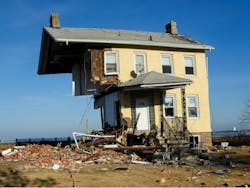Will New Jersey Lawmakers Step up for Microgrids before the Next Disaster?
As New Jersey prepares for a second round of funding for town center microgrids, some worry that the microgrids may never see the light of day.
The problem? The projects need an infusion of private money to go forward. But state rules make it difficult for government to partner with private industry on energy projects.
Town center microgrids are to New Jersey what community microgrids are in other states — generally complex projects designed to electrify multiple critical facilities, such as fire stations, hospitals, and wastewater treatment plants, during a power outage.
Still smarting from the onslaught of SuperStorm Sandy in 2012, the state allotted more than $2 million in 2017 to 13 town center microgrids chosen via a competitive application. The communities used the money for feasibility studies and now the state is preparing to announce a second round of funding for engineering studies.
But for the communities to move into development and construction, they need an infusion of private capital.
Public private partnership (P3) bill
Assemblyman Andrew Zwicker, a Democrat, a physicist and the only scientist in the New Jersey Legislature, believes he has a solution. Zwicker put forward a bill (A4535/S2958) that would allow public private partnerships, or P3, for energy infrastructure projects. The state would create an Energy P3 Unit to carry out the work.
“It provides the framework for how the state of New Jersey can and must partner with the private sector to develop energy-related projects and get them approved and get them built,” said Zwicker in a recent interview with Microgrid Knowledge.
The bill appears to have support, but it is moving at a crawl. Introduced October 15, 2018, the legislation won unanimous approval in May from the Assembly Science, Innovation and Technology Committee, which Zwicker chairs. On the Senate side, the Environment and Energy Committee also approved the bill without contest. (One member was absent.)
Despite its lack of controversy, the proposal has yet to make its way to the full legislature for a vote. Zwicker, who was recently re-elected to office, hopes lawmakers will take it up in the current 10-week lame duck session. But a bevy of other issues are monopolizing their time — legalizing marijuana, driver’s licenses for undocumented immigrants, business tax incentives, banning plastic bags and pension reform.
If no vote is taken during the lame duck session, the legislation must be refiled next year and go through the committee approval process again.
Meanwhile, industry stakeholders worry about New Jersey being unprepared for another storm like Sandy even though the technology is readily available now to keep power flowing to critical services. More than two million households lost power during the storm and the state’s economy took a $30 billion hit. Thirty-seven people died.
“The politics is not moving at the speed of technology,” said Alexander Aksanov the CEO of Barnaby Energy, a New Jersey-based developer, builder and operator of microgrids.
Without the approval of the pending legislation to authorize public private partnerships for microgrid development, the town microgrids, he said, “just won’t get built. And then the next storm is going to come through, power is going to go out. And there’s going to be more people that pass away, for reasons that should have never happened.”
Tipping point for New Jersey microgrids
Gail Lalla, a client manager at T&M Associates who worked on the Hoboken Resilient Microgrids Toolkit, also sees the legislation as crucial.
“We’re at the tipping point of getting a lot more projects to design build in possibly the course of a couple months — depending on whether we can move the needle on the regulatory/market side,” she said.
She noted that building a simple, standalone microgrid on a campus is not difficult — New Jersey has many. Town center microgrids are more complex and may cross utility rights of way, raising potential franchise issues.
Under the bill, either a government or private entity can propose a microgrid through a P3.
Join us in Philadelphia June 2-3 for Microgrid 2020: Distributed Energy and Electrification
The legislation also works to smooth the way for town center microgrids by:
- Permitting P3 to develop, design, build, operate, or maintain, energy projects, and to assume financial, developmental, operational, managerial and administrative responsibility
- Allowing the energy project to serve both government and privately owned buildings
- Not requiring that distributed energy resources within a microgrid be located on the customer’s property
- Letting a microgrid serve multiple customers, as long as one is a government entity
- Allowing a microgrid to use privately owned distribution wires to interconnect distributed energy with customers served by the microgrid and within its boundary
- Requiring a microgrid compensate the an electric utilities if it uses utility facilities
- Setting bidding, ownership and leasing parameters for government entities seeking private partners
New Jersey Assemblyman
Andrew Zwicker
For scientist/legislator, a bigger picture
As a scientist Zwicker has been deeply engaged in carbon reduction efforts. In addition to serving as a legislator, he is head of communications and public 0utreach at Princeton University’s Plasma Physics Laboratory. He sees P3 as part of a larger effort to help the state reach its climate and renewable energy goals. The state’s latest energy master plan, now in draft form, calls for 100% clean energy by 2050.
“How are we possibly going to get there?” he said. “The public sector and the private sector working together gives us the greatest opportunity to move as quickly as possible, so that it’s no longer a renewable energy future, but it is a renewable energy present.”
Track news about the progress of New Jersey’s town center microgrids. Subcribe to the free Microgrid Knowledge newsletter.
About the Author
Elisa Wood
Editor-in-Chief
Elisa Wood is the editor and founder of EnergyChangemakers.com. She is co-founder and former editor of Microgrid Knowledge.
